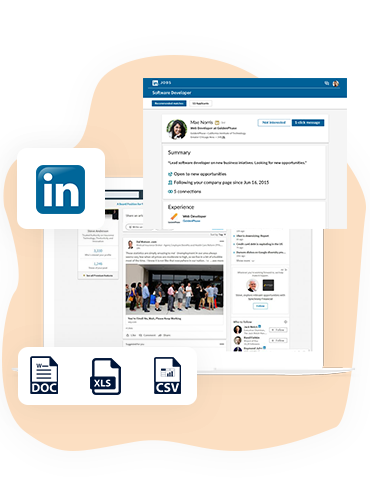- Python Web Scraping Sample
- Web Scraping Python Linkedin Example
- Web Scraping Python Linkedin Interview
Today we will scrape the data from this particular LinkedIn profile and save the HTML page in a local folder using python. We will scrape data from this profile. Here the main thing is we will scrape the page without login. I want to save the LinkedIn profile page locally in this folder linkedinpage in D drive I created using python.
- The LinkedIn crawl success rate is low; one request that a bot makes might require several retries to be successful. So, here we share the crucial Linkedin scraping guide lines. Rate limit Limit the crawling rate for LinkedIn. The acceptable approximate frequency is: 1 request every second, 60 requests per minute. Public pages only.
- Technical Manager (Python + MySQL + Web Scraping) We are looking for a Python Technical Manager responsible for efficient web scraping / web crawling and parsing.The ideal candidate will have demonstrated experience in web scraping and data extraction along with the ability to communicate effectively and adhere to set deadlines.
- View Python Web Crawling’s profile on LinkedIn, the world’s largest professional community. Python has 1 job listed on their profile. See the complete profile on LinkedIn and discover Python.
Released:
A python library to scrape post uploaded data from linkedin automatically.
Project description
Linkedin-Post-Scraper-With-Python is a python library to scrape post data on linkedin using browser automation.It currently runs only on windows.
Example
In this example we first import library, then we login with cookies and then scrape data of a post.
This module depends on the following python modules
BotStudio
bot_studio is needed for browser automation. As soon as this library is imported in code, automated browser will open up. Complete documentation for Linkedin Automation available here
Installation
Import

Login with credentials
Login with cookies
Get Post data
Send Feedback to Developers
Cookies

To login with cookies Edit this Cookie Extension can be added to browser. Please check this link how to get cookies to login to your linkedin.
Contact Us
Release historyRelease notifications | RSS feed
1.0.1
1.0.0
Download files
Download the file for your platform. If you're not sure which to choose, learn more about installing packages.
| Filename, size | File type | Python version | Upload date | Hashes |
|---|---|---|---|---|
| Filename, size linkedin-post-scraper-with-python-1.0.1.tar.gz (2.8 kB) | File type Source | Python version None | Upload date | Hashes |

 Close
CloseHashes for linkedin-post-scraper-with-python-1.0.1.tar.gz
| Algorithm | Hash digest |
|---|---|
| SHA256 | ecdea6545a8717b6da23b19c12f84cda566bb9868320ed412c9f9f33d9434ee9 |
| MD5 | 347b464284281afe5b43e2cd5072f160 |
| BLAKE2-256 | 1edb999694d2b7c851722503c45ce76b3e4b5e2284e3ada0e6b94bfd376ae4b8 |
Today I would like to do some web scraping of Linkedin job postings, I have twoways to go: - Source code extraction - Using the Linkedin API
I chose the first option, mainly because the API is poorly documented and Iwanted to experiment with BeautifulSoup.BeautifulSoup in few words is a library that parses HTML pages and makes it easyto extract the data.
Python Web Scraping Sample
Official page: BeautifulSoup web page
Now that the functions are defined and libraries are imported, I’ll get jobpostings of linkedin.
The inspection of the source code of the page shows indications where to accesselements we are interested in.
I basically achieved that by ‘inspecting elements’ using the browser.
I will look for “Data scientist” postings. Note that I’ll keep the quotes in mysearch because otherwise I’ll get unrelevant postings containing the words“Data” and “Scientist”.
Below we are only interested to find div element with class ‘results-context’,which contains summary of the search, especially the number of items found.
Now let’s check the number of postings we got on one page
Web Scraping Python Linkedin Example
To be able to extract all postings, I need to iterate over the pages, thereforeI will proceed with examining the urls of the different pages to work out thelogic.
url of the first page
https://www.linkedin.com/jobs/search?keywords=Data+Scientist&locationId=fr:0&start=0&count=25&trk=jobs_jserp_pagination_1
second page
https://www.linkedin.com/jobs/search?keywords=Data+Scientist&locationId=fr:0&start=25&count=25&trk=jobs_jserp_pagination_2
third page
https://www.linkedin.com/jobs/search?keywords=Data+Scientist&locationId=fr:0&start=50&count=25&trk=jobs_jserp_pagination_3
there are two elements changing :
- start=25 which is a product of page number and 25
- trk=jobs_jserp_pagination_3
I also noticed that the pagination number doesn’t have to be changed to go tonext page, which means I can change only start value to get the next postings(may be Linkedin developers should do something about it …)
As I mentioned above, all the information about where to find the job detailsare made easy thanks to source code viewing via any browser
Next, it’s time to create the data frame
Now the table is filled with the above columns.
Just to verify, I can check the size of the table to make sure I got all thepostings
In the end, I got an actual dataset just by scraping web pages. Gathering datanever have been as easy.I can even go further by parsing the description of each posting page andextract information like:
- Level
- Description
- Technologies
…
There are no limits to which extent we can exploit the information in HTML pagesthanks to BeautifulSoup, you just have to read the documentation which is verygood by the way, and get to practice on real pages.
Web Scraping Python Linkedin Interview
Ciao!
